

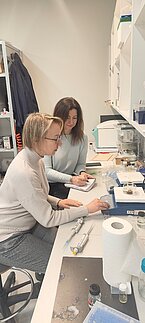
December 2023 — Two leading researchers from Ukravit Science Park have completed a month-long secondment aimed at enhancing their expertise in optical measurements and sensor technology.
From December 9, 2023, to January 9, 2024, Ms. Iryna Perekhrest, Head of the Service and Analytical Center, and Ms. Dina Husarova, Head of the Elemental Analysis Laboratory, participated in a collaborative initiative designed to foster research and provide specialized training opportunities.
During their secondment, the researchers gained foundational knowledge in optical measurements of solid-state and liquid samples and studied the basic principles of optical sensors. They conducted investigations into the sensitivity of Schiff base samples to metal ions using the absorbance method. Through this work, they defined target groups of ions for each sample and discovered substances sensitive to ions of iron, nickel, copper, cadmium, cobalt, and chromium. Basic sensor parameters were calculated, contributing valuable data to the development of advanced optical sensors.
Additionally, they received training on obtaining plant extracts, which can be instrumental in creating natural and environmentally friendly sensing materials.
This secondment not only enhanced their technical skills but also strengthened collaborative ties between Ukravit Science Park and the hosting institution. The knowledge and experience gained are expected to significantly contribute to ongoing and future projects in optical sensor technology and material sciences.

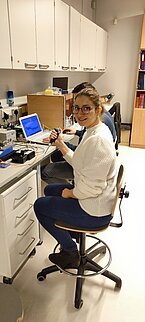


From November 3 to December 2, 2023, Experienced Researchers Dr. Martin Sahul and Dr. Barbora Ludrovcová, along with Early-Stage Researcher Mr. Róbert Bočák, are participating in a collaborative initiative aimed at fostering research and providing specialized training opportunities.
During the secondment, the researchers began with an orientation and introduction to the work plan and laboratory facilities, setting the groundwork for their intensive training. They received comprehensive instruction in Fourier Transform Infrared (FTIR) measurements for powder, liquid, and solid (multilayer coatings) samples. The team assembled and calibrated an optical system for photoluminescence measurements, which they used to analyze multilayer, powder, and biodegradable polymer samples.
They also focused on device assembly and sample preparation for reflectance measurements, gaining proficiency in reflectance and absorbance measurements utilizing Ocean Optics software. Their exploration of diffuse reflectance techniques for multilayer samples further enhanced their understanding of optical properties.
In addition, the researchers prepared and conducted transmittance measurements of metal ions in Schiff base solutions, specifically analyzing Mg, Zn, Co, Cu, Fe, Cr, and Al ions in various solutions. Attendance at a seminar hosted by the Institute of Atomic Physics and Spectroscopy enriched their theoretical knowledge and provided valuable networking opportunities.
Collaborating with the Faculty of Chemistry, they prepared chemical solutions essential for their experiments. A significant portion of their work involved the synthesis and continued development of ZnO nanocomposite materials
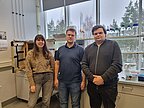

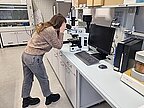

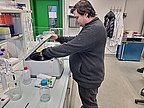
In November 2023, Visiting Research Assistant Iryna Tepliakova and Research Assistant Viktor Zabolotnii of the Laboratory of Optical Biosensors and Functional Nanomaterials of the Institute of Atomic Physics and Spectroscopy of the UL were on a mobility visit to the Lithuanian company "MB SensoGrafa". The mobility visit took place within the project "Novel optical nanocomposite sensors for analysis of micro and macro elements in corn plants" (contract No. 101086364 - SENS4CORN HORIZON-MSCA-2021-SE-01) within.
During the visit, I.Tepliakova studied Schiff base, benzimidazole ligands with Raman, FT-IR, photoluminescence and absorption methods. I.Tepliakova participated in the training on Raman spectroscopy. For each ligand, the optimal types of solvents were determined for sensitivity measurements of ligand concentrations in solution. Testing of ligand solution sensors for sensitivity determination of various metal ions (Zn2+, Cd2+, Mn2+, Cu2+, Al3+, Fe3+, Cr3+, Co2+, etc.) by photoluminescence and absorption methods was provided.
On the other hand, V. Zabolotnii defined the structural properties of SB using FTIR and Raman spectroscopy. Optimum solvents for each ligand and ionic salts were determined. Sensitivity to Cd, Zn, Cu, Pb, Fe ions will be observed for the ligands. Based on this, further synthesis of SB-based nanocomposites is planned.
The results obtained during the mobility visit will be approved at conferences, a joint publication is planned, they will be used as a basis for future projects.

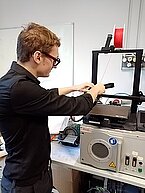

November 2023 — A team from the Institute of Atomic Physics and Spectroscopy at the University of Latvia, including Dr. Roman Viter, Head of the Laboratory of Optical Biosensors and Functional Nanomaterials, Dr. Mindaugas Tamošiūnas, Lead Researcher, and Engineer Mr. Kārlis Grundšteins, conducted a mobility visit to the Lithuanian company MB SensoGrafa during October and early November 2023. The visit was part of the project "Novel Optical Nanocomposite Sensors for Analysis of Micro and Macro Elements in Corn Plants" (contract No. 101086364 - SENS4CORN HORIZON-MSCA-2021-SE-01).
During the visit, Dr. Tamošiūnas and Dr. Viter performed measurements using Attenuated Total Reflectance (ATR) mode of Diffuse Reflectance Infrared Fourier Transform Spectroscopy (DRIFTS) and Fourier Transform Infrared (FTIR) spectroscopy. It was determined that the DRIFTS method is not suitable for powder samples with a thin nanoscale coating of the functional ligand. They received training in confocal Raman spectroscopy for sample testing. Zinc oxide-Schiff base (ZnO-SB) and zinc oxide-metal-organic framework (ZnO-MOF) samples were investigated using Raman spectroscopy at two wavelengths (523 nm and 785 nm), confirming the formation of composites. The collected FTIR and Raman data will be analyzed alongside optical spectroscopy measurements. Additionally, Zeta potential tests are planned to be performed in Riga.
Engineer Kārlis Grundšteins expanded his expertise in 3D printing technologies using materials such as Thermoplastic Polyurethane (TPU), polypropylene, and polycarbonate. He learned about the optimization of integrated systems and their adaptation for optical sensors. Mr. Grundšteins designed and printed test sensor cells using Polylactic Acid (PLA) and TPU polymers. He improved sensor designs utilizing polycarbonate for enhanced high-temperature resistance and integrated cell samples for optical and electrochemical chips. Furthermore, he conducted electrochemical measurements using the sensor cells.

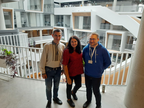

Mr. Volodymyr Konohrai, Head of the Agrobiological Laboratory at Ukravit Science Park, has successfully completed a one-month secondment at Institute of Atomic Physics and SPectroscopy, University of Latvia focused on advancing his expertise in optical sensor testing and plant sample analysis.
From September 30 to November 1, 2023, Mr. Konohrai participated in a collaborative initiative aimed at enhancing research and providing specialized training opportunities in optical spectroscopy, photoluminescence (PL), and Fourier Transform Infrared (FTIR) spectroscopy.
During his secondment, Mr. Konohrai received comprehensive training in fundamental optical research methods and gained in-depth knowledge of working with optical sensors. He conducted sensory testing of metal ions using both cuvette-based systems and microfluidic setups, enhancing his proficiency in detecting metal ions through photoluminescence methods.
He prepared nanocomposites based on zinc oxide (ZnO) and Schiff bases (SB), and performed sensitivity measurements of these composites to metal ions. This work is significant for developing advanced sensors capable of detecting trace metal ions in various environmental and agricultural applications.
In addition to his work on nanocomposites, Mr. Konohrai prepared samples of healthy and diseased plants to investigate their optical properties. He conducted photoluminescence measurements to study the kinetics of chlorophyll peaks under UV radiation and performed FTIR analysis to compare the molecular structures of healthy and diseased samples. These studies contribute valuable insights into plant health diagnostics and the development of optical methods for monitoring plant conditions

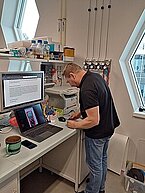


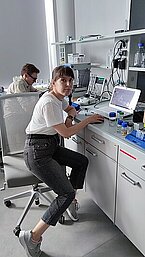
From 30 June to 29 July 2023, Roman Viter, head of the Laboratory of Optical Biosensors and Functional Nanomaterials of the Institute of Atomic Physics and Spectroscopy of the University of Latvia, along with engineer Karlis Grundsteins, guest researcher Irina Teplyakova and researcher Viktor Zabolotnij, undertook a mobilisation visit to the Lithuanian company MB SensoGrafa. The visit was conducted as part of the project "New optical nanocomposite sensors for analysis of micro- and macronutrients in maize plants" (contract No. 101086364 - SENS4CORN HORIZON-MSCA-2021-SE-01).
During his visit, Mr. Viter received training in the assembly of liquid systems using peristaltic pumps, the design of sensor systems, and the fabrication of parts using 3D printers. Mr. Grundstein expanded his expertise in optical sensor design, and successfully constructed an optical photoluminescent system utilising microfluidics. I. Teplyakova received training in the assembly and installation of microfluidic systems with peristaltic pumps, as well as in the preparation and testing of biosensors by electrochemical methods. V. Zabolotnyi underwent training in the assembly and installation of an optical photoluminescent system, as well as preliminary testing of ZnO-based nanostructures for Cu²⁺, Fe³⁺, Cd³⁺, Al³⁺ and Cr³⁺ ions

 CONFERENCE
CONFERENCE